|
| |
Archives
iraq
Who Cares About Iraqis?
by Dahr Jamail
|
Suicide bombers unleashed another day of hell across Iraq today, killing at least 18 and wounding over 67.
| |
[more]
Building Iraq's Army: Mission Improbable
roject in North Reveals Deep Divide Between U.S. and Iraqi Forces
|
"I know the party line. You know, the Department of Defense, the U.S. Army, five-star generals, four-star generals, President Bush, Donald Rumsfeld: The Iraqis will be ready in whatever time period," said 1st Lt. Kenrick Cato, 34, of Long Island, N.Y., the executive officer of McGovern's company, who sold his share in a database firm to join the military full time after the Sept. 11, 2001, attacks. "But from the ground, I can say with certainty they won't be ready before I leave. And I know I'll be back in Iraq, probably in three or four years. And I don't think they'll be ready then."
| |
[more]
thanks to Political Animal
Former CIA director calls for Iraq withdrawal
|
Former CIA Director John M. Deutch, institute professor at the Massachusetts Institute of Technology (MIT), said that the United States is not making progress toward key objectives in Iraq and called for American troops to pull out "as soon as possible" during a speech Tuesday (June 7) at Harvard's Sanders Theatre.
| |
[more]
thanks to Antiwar.com
ruins
The Fabulous Ruins of Detroit
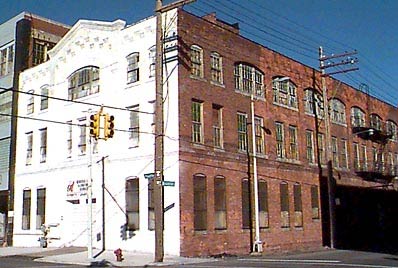
It was here that Henry Ford established his first big plant, the Ford Piquette Avenue Plant, in 1904. It was here that he first produced his famous Model T automobile in 1908.
[more]
thanks to wood s lot
oil
Crude Awakening
The only hope for meeting growing world demand for oil, say experts, is to tap Saudi Arabia's reserves. A Bush advisor on energy says those reserves don't exist.
|
As recently as a few years ago, only two groups of people were interested in the arid subject of oil depletion. The first was Texas oil moguls and their lobbyists who roamed the halls of Congress searching out ever juicier tax breaks from our elected representatives. The second was a tiny group of cranks and conspiracy theorists who not only wrote for Scientific American but also frequented the sparsely inhabited corners of the Internet and begged the world to pay attention to the obscure topic of “peak oil”—whether the world wanted to pay attention or not. Fast forward to 2005, and the oil moguls haven't changed much. The peak oil cranks, on the other hand, are cranks no longer. In fact, they've practically become rock stars. Half a dozen books on the subject have come out in the last two years, and magazines from Rolling Stone to National Geographic also have published articles on the subject. The “end of oil” is suddenly a hot topic.
| |
[more]
The above is a book review of Matthew Simmons "Twilight in the Desert." The following is a three part interview with Matthew Simmons
Peak Oil, Saudi Arabia: Part 1
Peak Oil Part 2: Saudi Arabia Decline Rate And The Possiblities Of A Production Collapse
Peak Oil 3: Not Sustainable But Insatiable
photography
Stanley Kubrick gives Chicago a Look
Rare, unpublished photos reveal the early visual handiwork of a great filmmaker
|
Few people know that before he started making movies, Stanley Kubrick was a star photojournalist.
Six weeks after graduating from high school, Kubrick went to work for Look magazine the way other kids went to college.
Much later, Kubrick called his job at Look "a miraculous break." It taught him a lot about photography, but more that that, Look "gave me a quick education in how things happened in the world." In the summer of 1949, Look sent him to Chicago to shoot the pictures for a story by Irv Kupcinet. He brought back 40 rolls of film and a rare record of his own education as a filmmaker.
| |
[more]
thanks to RangefinderForum.com
Stanley Kubrick's Chicago
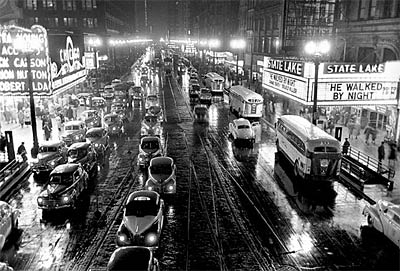
[more]
thanks to RangefinderForum.com
economy
Losing Our Country
by Paul Krugman
|
Baby boomers like me grew up in a relatively equal society. In the 1960's America was a place in which very few people were extremely wealthy, many blue-collar workers earned wages that placed them comfortably in the middle class, and working families could expect steadily rising living standards and a reasonable degree of economic security.
But as The Times's series on class in America reminds us, that was another country. The middle-class society I grew up in no longer exists.
Working families have seen little if any progress over the past 30 years. Adjusted for inflation, the income of the median family doubled between 1947 and 1973. But it rose only 22 percent from 1973 to 2003, and much of that gain was the result of wives' entering the paid labor force or working longer hours, not rising wages.
Meanwhile, economic security is a thing of the past: year-to-year fluctuations in the incomes of working families are far larger than they were a generation ago. All it takes is a bit of bad luck in employment or health to plunge a family that seems solidly middle-class into poverty.
| |
[more]
drug ads
Drugs
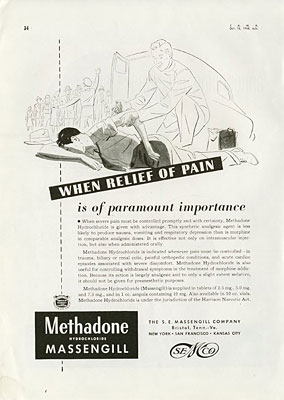
[more]
thanks to Coudal Partners
he was a crook
The Real Lessons of Watergate
|
As the Washington Post again basks in the faded glory of its Watergate coverage, many of the scandal’s crucial lessons remain obscure even to people close to the iconic events of 33 years ago. Ironically, that’s especially true for those on the winning side.
Indeed, it could be said that today’s U.S. political imbalance – tilting so much in favor of Republicans over Democrats – derived from the simple fact that conservatives learned the real lessons of Watergate while the liberals didn’t.
Most importantly, the bitter experience of Watergate taught the conservatives the need to control the flow of information at the national level.
| |
[more]
Deep Throat, Inc.
|
I don’t want to spoil the party, but while everyone’s celebrating Deep Throat as if he
"solved" Watergate, the real culprit, the perpetrator of the initial crime, the man who actually ordered the Watergate break-in, has escaped.
That would be Richard Nixon, who was driven from office because he covered up the crime of others, not because he ordered the crime himself. In fact, if you accept Nixon’s story at face value, as all too many journalists and historians have—the story Nixon repeated in his memoirs, the one he took to his grave—Nixon didn’t order the Watergate burglary. Indeed, he was deeply shocked when he learned about it in the papers the next day. And he proceeded to sacrifice his Presidency in order to cover up for the overzealous acts (including the burglary) of his loyal subordinates
As Rutgers professor David Greenberg, the author of the valuable study Nixon’s Shadow, wrote in a New York Times op-ed in 2003: "[M]ost historians have absolved him of blame" for ordering the break-in. And so have most journalists. Either that or they try to trivialize the question, as if it didn’t make a difference whether Nixon essentially got away with the crime that started it all—and the lie about his role
This is the real scandal for journalists: Amidst the orgy of nostalgic self-congratulation that the Mark Felt revelation has prompted, it seems to have been forgotten that journalists have abandoned the most basic crime-reporter responsibility—pin down whodunit. As in who ordered it. None of the official investigations, the Senate Watergate Committee, the House Impeachment Committee, the Special Prosecutor’s report were able to pin it directly on Nixon. As a result, as Mr. Greenberg attests, in most mainstream biographies and histories of Nixon and Watergate, Nixon gets a pass. He lied about everything else, but on this one thing—the initiating act of the fall of a government—we should just take his word; he’s telling the whole truth
| |
[more]
thanks to DANGEROUSMETA!
book art
The Russian Avant-Garde Book 1910-1934
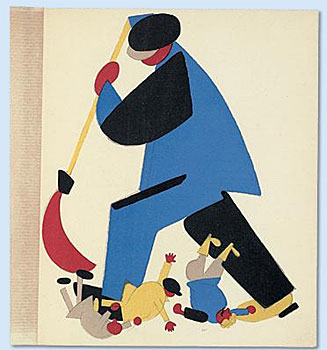
[more]
thanks to Conscientious
Wonderful stuff!
family values
Quotes from the The American Taliban
|
"Being nice to people is, in fact, one of the incidental tenets of Christianity, as opposed to other religions whose tenets are more along the lines of 'kill everyone who doesn't smell bad and doesn't answer to the name Mohammed'" ~ Ann Coulter
"Yes, religion and politics do mix. America is a nation based on biblical principles. Christian values dominate our government. The test of those values is the Bible. Politicians who do not use the bible to guide their public and private lives do not belong in office." ~ Beverly LaHaye
"I don't know that atheists should be considered citizens, nor should they be considered patriots. This is one nation under God." ~ George Bush Sr.
| |
[more]
thanks to Politics in the Zeros
all together now
The Schneider G-Claron 210 that Marja-Leena sent me is finally in a lens board and ready to use!
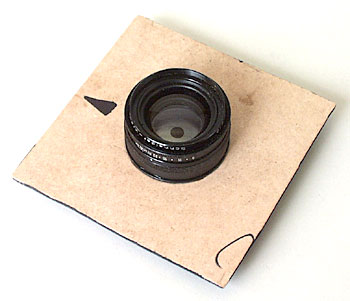
I epoxied 3 layers of hardboard. All precisely cut with a jig saw. Ha! Close enough, anyway.
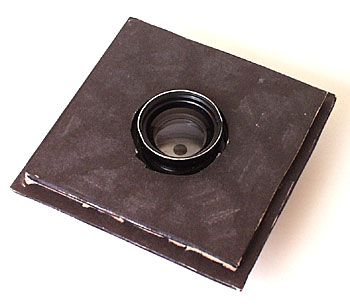
If you look closely you can see what a fine circle I cut. The paint job was with a Sharpie pen. The lens came with a mounting ring that I just epoxied onto the board. The barrel screws into the mounting ring.

Then I cut out an adapter that bolts onto the Packard shutter and slides onto the lens.
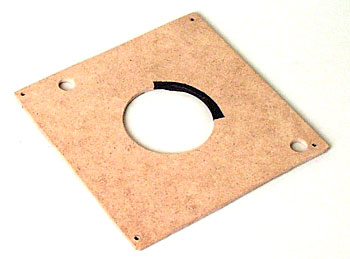
This is the back side of the adapter that faces the lensboard. I used a hole saw and the hole just needed a small piece of gaffer's tape to give a nice tight fit. The small corner holes are for bolting onto the shutter and the other two holes are clearance holes for the pin.
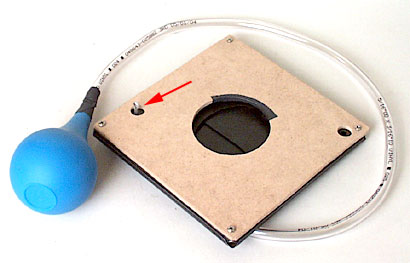
The arrow shows where the pin goes for the instantaneous exposure.
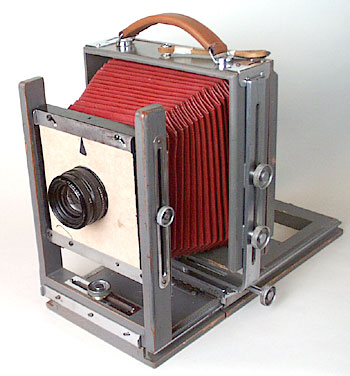
The Burke and James with the G-Claron installed.
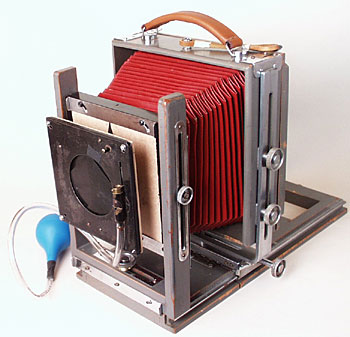
The Packard shutter just slides onto the lens.
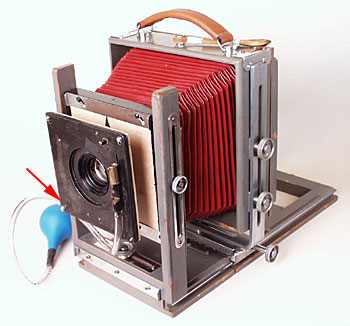
A press of the bulb and the shutter opens. The arrow shows where the pin goes to hold the leaves open for longer exposures. Saves the hand from cramping up squeezing the bulb. I'm running out of excuses for not taking pictures with this camera. Actually, I've been using it for product photography with the 120 roll film back and the Ektar 127. It really needs to have some 4x5 sheet film exposed in it. It told me so.
iraq
'This Is the Freedom America Has Brought Us'
by Dahr Jamail
|
The mayhem continues in Iraq, with at least 40 people dead today including five U.S. soldiers in Diyala province, as the meltdown of the failed U.S.-led occupation continues.
| |
[more]
Good Intentions Gone Bad
NEWSWEEK's Baghdad bureau chief, departing after two years of war and American occupation, has a few final thoughts.
|
Two years ago I went to Iraq as an unabashed believer in toppling Saddam Hussein. I knew his regime well from previous visits; WMDs or no, ridding the world of Saddam would surely be for the best, and America's good intentions would carry the day. What went wrong? A lot, but the biggest turning point was the Abu Ghraib scandal. Since April 2004 the liberation of Iraq has become a desperate exercise in damage control. The abuse of prisoners at Abu Ghraib alienated a broad swath of the Iraqi public. On top of that, it didn't work. There is no evidence that all the mistreatment and humiliation saved a single American life or led to the capture of any major terrorist, despite claims by the military that the prison produced "actionable intelligence."
[...]
The most powerful army in human history can't even protect a two-mile stretch of road. The Airport Highway connects both the international airport and Baghdad's main American military base, Camp Victory, to the city center. At night U.S. troops secure the road for the use of dignitaries; they close it to traffic and shoot at any unauthorized vehicles. More troops and more helicopters could help make the whole country safer. Instead the Pentagon has been drawing down the number of helicopters. And America never deployed nearly enough soldiers. They couldn't stop the orgy of looting that followed Saddam's fall. Now their primary mission is self-defense at any cost—which only deepens Iraqis' resentment.
| |
[more]
thanks to Juan Cole
U.S. death toll in Iraq surges amid rebel violence
|
The death toll for American troops in Iraq rose in May to the highest level since January, with the U.S. military saying on Tuesday insurgents have doubled their number of daily attacks since April.
| |
[more]
thanks to Antiwar.com
When the Funk Hits the Fan
|
Michael Ledeen, who was the only kid in elementary school with a Machiavelli lunchbox, is peeved. President Bush isn't prosecuting the war on terror and implementing the neoconservative shake-and-bake agenda in the Mideast as hard and fast as he would like.
He hates when that happens.
| |
[more]
Pilot Training Time Slashed
|
Tight budgets are forcing the Air Force's combat squadrons to cut back their training hours by nearly 60 percent -- "leaving frontline units unprepared to go to war," according to Defense News.
[...]
This is bad news -- another sign of how the Iraq war is slowly grinding down American military readiness. But are times really that tight at the Air Force? I mean, if the generals there wanted to save $272 million, couldn't they just take a F-22 Raptor or two out of the budget, instead of staging a giant PR campaign for the dubious stealth jet? Is an extra fighter plane that much more important than every pilot's training time?
| |
[more]
photography
Frank Hurley is one of the most amazing photographers. In addition to being good, he was good under the most trying circumstances. He was the photogapher for Shackleton's expedition to Antartica. But that wasn't enough.
Frank Hurley, “the mad photographer”
|
In 1917 James Francis Hurley (1885-1962) became the first offical photographer to the Australian Imperial Forces. When he arrived at the Western Front his rank was honorary captain, but the troops, seeing how he took risks to get his pictures, dubbed him “the mad photographer”.
| |
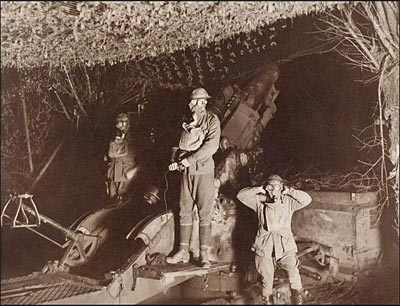
[more]
thanks to consumptive.org
labor
The US Labor Force: One Foot in the Third World
Welcome to a Has-Been Country
|
In May the Bush economy eked out a paltry 73,000 private sector jobs: 20,000 jobs in construction (primarily for Mexican immigrants), 21,000 jobs in wholesale and retail trade, and 32,500 jobs in health care and social assistance. Local government added 5,000 for a grand total of 78,000.
Not a single one of these jobs produces an exportable good or service. With Americans increasingly divorced from the production of the goods and services that they consume, Americans have no way to pay for their consumption except by handing over to foreigners more of their accumulated stock of wealth. The country continues to eat its seed corn.
Only 10 million Americans are classified as "production workers" in the Bureau of Labor Statistics nonfarm payroll tables. Think about that.
The US with a population approaching 300 million has only 10 million production workers. That means Americans are consuming the products of other countries labor.
| |
[more]
photography
pinhole photography
by Mieko Tadakoro
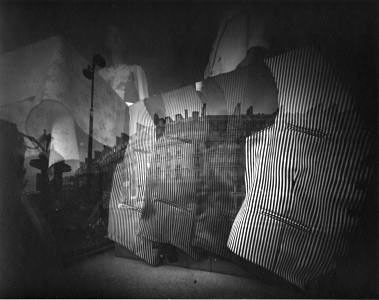
[more]
empire
Tomgram: It’s a Pentagon World and Welcome to It
|
The last few weeks have been base-heavy ones in the news. The Pentagon's provisional Base Realignment and Closure (BRAC) list, the first in a decade, was published to domestic screams of pain. It represents, according to the Washington Post, "a sweeping plan to close or reduce forces at 62 major bases and nearly 800 minor facilities" in the United States. The military is to be reorganized at home around huge, multi-force "hub bases" from which the Pentagon, in the fashion of a corporate conglomerate, hopes to "reap economies of scale." This was front page news for days as politicians and communities from Connecticut (the U.S. Naval Submarine Base in Groton) and New Jersey (Fort Monmouth) to South Dakota (Ellsworth Air Force Base) cried bloody murder over the potential loss of jobs and threatened to fight to the death to prevent their specific base or set of bases (but not anyone else's) from closing -- after all, those workers had been the most productive and patriotic around. These closings -- and their potentially devastating after-effects on communities -- were a reminder (though seldom dealt with that way in the media) of just how deeply the Pentagon has dug itself into the infrastructure of our nation. With over 6,000 military bases in the U.S., we are in some ways a vast military camp.
But while politicians screamed locally, Donald Rumsfeld's Pentagon never thinks less than globally; and, if you throw in the militarization of space, sometimes even the global has proven too small a framework for its presiding officials. For them, the BRAC plans are just one piece of a larger puzzle that involves the projection of American power into the distant lands that most concern us. After all, as Chalmers Johnson has calculated in his book, The Sorrows of Empire, our global Baseworld already consists of at least 700 military and intelligence bases; possibly -- depending on how you count them up -- many more. Under Rumsfeld's organizational eye, such bases have been pushed ever further into the previously off-limits "near abroad" of the former Soviet Union (where we now probably have more bases than the Russians do) and ever deeper into the Middle Eastern and Caspian oil heartlands of the planet.
The Bush administration's fierce focus on and interest in reconfigured, stripped down, ever more forward systems of bases and an ever more powerfully poised military "footprint" stands in inverse proportion to press coverage of it. To the present occupants of the Pentagon, bases are the equivalent of imperial America's lifeblood and yet basing policy abroad has, in recent years, been of next to no interest to the mainstream media.
| |
[more]
photography
Berthold Steinhilber
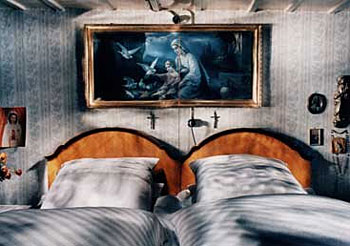
[more]
The Resurrection of the Stones
Rising stark against the night sky, spectral ruins recall the wealth and power of Britain's once-great monasteries

[more]
thanks to wood s lot
Ghost Towns by Night Light
oil
Oil: Caveat empty
|
Without any press conferences, grand announcements, or hyperbolic advertising campaigns, the Exxon Mobil Corporation, one of the world's largest publicly owned petroleum companies, has quietly joined the ranks of those who are predicting an impending plateau in non-OPEC oil production. Their report, The Outlook for Energy: A 2030 View, forecasts a peak in just five years.
In the past, many who expressed such concerns were dismissed as eager catastrophists, peddling the latest Malthusian prophecy of the impending collapse of fossil-fueled civilization. Their reliance on private oil-reserve data that is unverifiable by other analysts, and their use of models that ignore political and economic factors, have led to frequent erroneous pronouncements. They were countered by the extreme optimists, who believed that we would never need to think about such problems and that the markets would take care of everything. Up to now, those who worried about limited petroleum supplies have been at best ignored, and at worst openly ridiculed.
Meanwhile, average consumers have taken their cue from the market, where rising prices have always been followed by falling prices, leading to the assumption that this pattern will continue forever. In truth, the market price of crude oil is completely decoupled from and independent of production costs, which average about $6 per barrel for non-OPEC producers and $1.50 per barrel for OPEC producers. This situation has nothing to do with a free market, and everything to do with what OPEC believes will be accepted or tolerated by the United States. The completely affordable market price--what consumers pay at the gasoline pump--provides magisterial profits to the owners of the resource and gives no warning of impending shortages.
All the more reason that the public should heed the silent alarm sounded by the ExxonMobil report, which is more credible than other predictions for several reasons. First and foremost is that the source is ExxonMobil. No oil company, much less one with so much managerial, scientific, and engineering talent, has ever discussed peak oil production before. Given the profound implications of this forecast, it must have been published only after a thorough review.
| |
[more]
thanks to The Agonist
camera straps
I added another color for neck straps — natural leather with red thread, at gordy coale's camera straps.


iran
The ties that bind China, Russia and Iran
|
The military implementation of the George W Bush administration's unilateralist foreign policy is creating monumental changes in the world's geostrategic alliances. The most significant of these changes is the formation of a new triangle comprised of China, Iran and Russia.
Growing ties between Moscow and Beijing in the past 18 months is an important geopolitical event that has gone practically unnoticed. China's premier, Wen Jiabao, visited Russia in September 2004. In October 2004, President Vladimir Putin visited China. During the October meeting, both China and Russia declared that Sino-Russian relations had reached "unparalleled heights". In addition to settling long-standing border issues, Moscow and Beijing agreed to hold joint military exercises in 2005. This marks the first large-scale military exercises between Russia and China since 1958.
The joint military exercises complement a rapidly growing arms trade between Moscow and Beijing. China is Russia's largest buyer of military equipment. In 2004, China was reported to have signed deals worth more than $2 billion for Russian arms. These included naval ships and submarines, missile systems and aircraft. According to the head of Russia's armed forces, Anatoliy Kvashnin, "our defense industrial complex is working for this country [China], supplying the latest models of arms and military equipment, which the Russian army does not have". Russia's relations with China are not limited to military trade. In the past five years, non-military trade between Russia and China has increased at an average annual rate of nearly 20%. Moscow and Beijing have targeted non-military trade to reach $60 billion by 2010, from $20 billion in 2004. One of the key components of commercial trade is Russian energy exports to China.
| |
[more]
of packard shutters and barrel lenses
This is a pretty arcane post. I can think of only two people that might find this of use. Blaine, who has probably already figured these out, and Ken, who has some Russian barrel lenses and needs one of these if he doesn't already have one. But although of limited use you might find this of interest. It's old technology that is still very useful, particularly if you want to use cheap, but very good, shutterless lenses on a view camera.
Most view camera lenses come mounted in shutters.
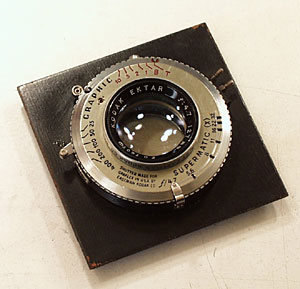
The shutter performs two functions: it opens and closes a series of leaves at the speed indicated and opens the iris to the set f stop. But shutters are not cheap. There are inexpensive lenses that can be had that don't have shutters. They are often found in copy cameras and are called barrel lenses.

This is the sharpest lens I own, a Schneider G-Claron. It use to live in a copy camera and is mounted in a barrel lens. View camera lens are made of two elements, front and back (duh!), that can be unscrewd.

The barrel contains the iris and separates the lens elements at the proper distance. But what about a shutter? A hat works, or a lens cap. If you are using exposures longer that a second you can simply uncover and cover the lens with the lens cap. But there is a more elegant solution — the Packard shutter.
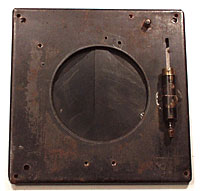
These can be mounted behind the lens or in front of the lens. I've had this one for 30 years. Never thought that it would be actually usefull. They still build them. This is a 5x5 with a 2 3/4 inch opening. It's a little over 1/4 inch think not including the air cylinder. A new one will run close to $150 with bulb and hose. There is a little cylinder on the right side of the shutter. You attach a hose with a squeeze bulb on it and squeeze. The air pushes the cylinder up and, since it is attached to the leaves inside, the leaves open.
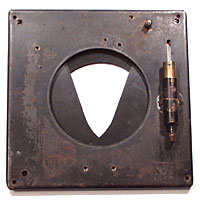
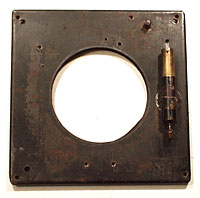
Once it's open you count off the seconds, still squeezing the bulb, and then release the bulb and the leaves close. Cool! But wait! There's more! There are two kinds of Packard shutters — a #5 and a #6. The #5 does what I just described. A #6 can also do instantaneous exposures of around 1/25 of a second. You squeeze the bulb and it opens and then immediately closes. While reading about front mounting Packard shutters, it mentioned that #6 shutters often had solenoids for flashes. Mine had one. And that a pin was inserted in the back so that the instantaneous exposure would happen. I turned mine around and there was a hole for a pin and that explained what the little cylinder on the front was and what the extra leaf in the shutter did.
Here is how that works. This is my #6 Packard shutter with the cover off. I've colorized two of the leaves to make it clearer.
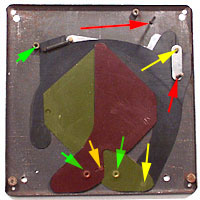 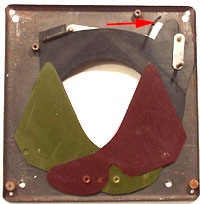
On the left image, the upper red arrow shows the inserted pin. The lower red arrow is where the air piston pushes up. This works because all the pieces are pinned together. The upper yellow arrow attaches the piece being moved by the piston to the aluminum piece underneath and the black piece in between. The black piece is attached to the yellow piece at the lower right yellow arrow and the yellow piece is attached to the red piece at the lower left yellow arrow. As the pieces move they pivot around pivot points which are identified by the lower green arrows. The upper green arrow as a post that acts as a constraint to the black piece to keep it from moving to the left. The second picture shows where the aluminum piece is hitting the pin as the air piston moves it up. If the pin wasn't there it would just continue straight up to open the leaves. This is where it gets interesting.
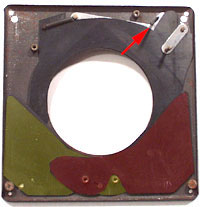 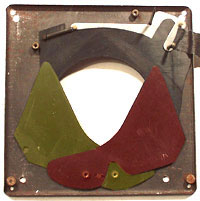
As the piston continues to move up the aluminum piece is slid right as it moves up the pin. This slides the pin that has been moving the black piece up out of the black piece. The pin inserted from the back is now in the notch of the aluminum piece and the leaves are open. As the piston continues up the aluminum piece starts to rotate around the pin and the left end of the aluminum piece is now pushing the black piece down which causes the other two pieces to close.
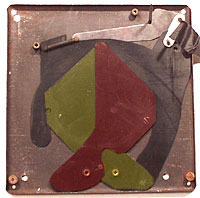
The air piston has moved to its highest position and the leaves are closed. Releasing the bulb causes the piston to go down and the aluminum pieces moves down and the spring pulls it back into the indent on the black piece ready to be opened again.
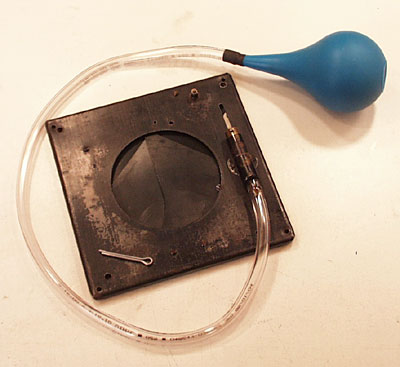
Here it is ready for action. At Blaine's suggestion, I went to our local Ace Hardware for the tubing and our local drugstore for the baby ear cleaning bulb. The cotter pin is what I use for the pin. There is a hole to the left of the cotter pin. If you have along exposure you can insert the pin in that hole and it will lock the leaves open. Now to make the adapter to mount it to the lenses. Actually two adapters. One for the G-Claron and one for the Carl Zeiss Jena Tessar 210/3.5.
|
|
|
|































